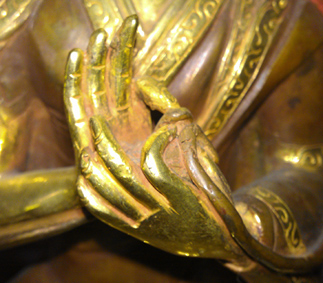

"Seeking but not finding the house-builder,
I traveled through life after life.
How painful is repeated birth !
House-builder ! You have now been seen.
You will not build the house again !"
Dhammapada, verses 153 & 154.
This subdomain of the website serves as a guide to understanding the foundational aspects of Buddhism. It offers a rich tapestry of topics that delve into the core teachings, philosophies, and practices that have shaped Buddhism over the millennia. Each point offers a unique lens through which to explore Buddhist philosophy, making it an invaluable resource for anyone interested.
The Introduction is a prologue, offering a bird's-eye view of the Buddhadharma and its various paths. It sets the tone for the subsequent exploration of the intricate facets of Buddhism, providing a roadmap for the journey ahead.
On Buddha Śākyamuni : The Enlightened One
This section is a biographical sketch of Buddha Śākyamuni, the historical Buddha. It delves into his life, teachings, and his impact on the world. His life and teaching are foundational pillars upon which the rest of the Buddhist teachings stand.
On the Dharma : The Universal Law
Exploring the concept of Dharma, the universal law, and the teachings of the Buddha. It assists in understanding the ethical and philosophical framework that governs Buddhist thought and practice.
On the Sangha : The Dynamic Community
Redefining the notion of Sangha, presenting it as a dynamic, ever-evolving community.
On the Buddhayāna : The Vehicle of Enlightenment
This part focuses on the vehicles that carry one towards enlightenment. It explores the different paths within Buddhism, offering a view of the paths towards liberation.
On the Four Seals : The Philosophical Backbone
The Four Seals—impermanence, suffering, emptiness, and Nirvāṇa—characterize all Buddhist philosophies. It provides the fundamentals governing the Buddhist view.
On the Canon : The Sacred Texts
Here, the Buddhist canon is explored, the collection of texts constituting the scriptural foundation of Buddhism. It offers insights into the Pali Canon, the Mahāyāna Sūtras, and other important texts.
On the Four Noble Truths : The Core Teachings
This section delves into suffering, its cause, its cessation, and the path to its cessation. These are the first foundational teachings given by the Buddha.
On the Eightfold Path : The Way to Liberation
The Eightfold Path is the practical guide to achieving liberation. It outlines the ethics, meditations, and wisdom required.
On the Two Truths : Conventional and Ultimate Reality
This part discusses conventional and ultimate reality. It explores how understanding both is crucial for attaining enlightenment.
On Saṃsāra : The Cycle of Existence
The cycle of birth, death, and rebirth is discussed in detail. The section explores the mechanics of karma and how one can break free from this cycle.
On Nirvāṇa : The Ultimate Goal
The ultimate goal of Buddhist practice is at hand. The characteristics and qualities of this enlightened state are discussed.
On the Lesser, Individual Vehicle : The Path of the Arhat
The focus is on the Lesser Vehicle, also known as Theravāda Buddhism. The path of the Arhat is discussed. This is someone who has achieved liberation, not Buddhahood.
On Merit : The Currency of Goodness
The concept of merit, the spiritual 'currency' accumulated through good deeds, is elaborated, exploring how merit can aid in one's spiritual journey.
On Method : The Means to an End
Various methods and practices within Buddhism offer a practical guide to awakening.
On Meditation : The Tool for Calmness and Insight
This section focuses on meditation as the primary tool for gaining tranquillity and, based on this, insight into the nature of reality.
On the Great Vehicle : Mahāyāna Buddhism
The Mahāyāna path, known as the Great Vehicle, is surveyed. It focuses on the Bodhisattva ideal and the aspiration to awaken for the benefit of all beings.
On the Bodhisattva : The Altruistic Path
The Bodhisattva ideal is the path of altruism and compassion.
What are the qualities and vows of the Bodhisattva ?
On Compassion : The Heart of Mahāyāna Buddhism
The role of compassion in Mahāyāna practice is essential and presented as an essential quality for awakening or Buddhahood.
On Bodhicitta : The Mind of Enlightenment
Exploring the aspiration to achieve enlightenment for the benefit of all beings is considered the motivating force behind the Bodhisattva path.
On Emptiness : The Nature of Reality
What is emptiness, and how can it be realized ?
On The Diamond Vehicle : Vajrayāna
The Diamond Vehicle is the esoteric form of Buddhism prevalent in Tibet. It focuses on Tantra and Deity Yoga as a means to rapid enlightenment.
On Rebirth : The Continuity of Consciousness
The section on rebirth explores the Buddhist view on the continuity of consciousness after death and its implications for practice.
On Dzogchen : Utmost Yoga
This section explores Dzogchen, the Great Completion, considered the highest and most direct path to enlightenment.
These are the main topics.
Many more are investigated.
In conclusion, this subdomain is a reliable resource for those interested in studying and practicing Buddhism. The website offers a nuanced amalgamation of traditional Buddhist teachings and contemporary interpretations, making it a unique platform that caters to academic scholars and spiritual practitioners. Its extensive coverage of topics, ranging from foundational principles like the Four Noble Truths to specialized forms of Buddhism such as Vajrayāna, provides a comprehensive understanding of Buddhist philosophy.
The website's pedagogical approach combines scholarly rigor with practical applicability, making it a tool for those seeking to deepen their theoretical understanding and practical engagement with Buddhist teachings. Furthermore, the site's accessibility and interface make it a readily available resource. It is not merely an informational repository but a dynamic educational platform facilitating a deeper understanding of Buddhism. It serves as both a compass and a map, guiding users through the complex landscape of Buddhist thought and practice. Given its epistemic value and practical utility, it may assist anyone serious about delving into the multifaceted world of Buddhist philosophy and practice.